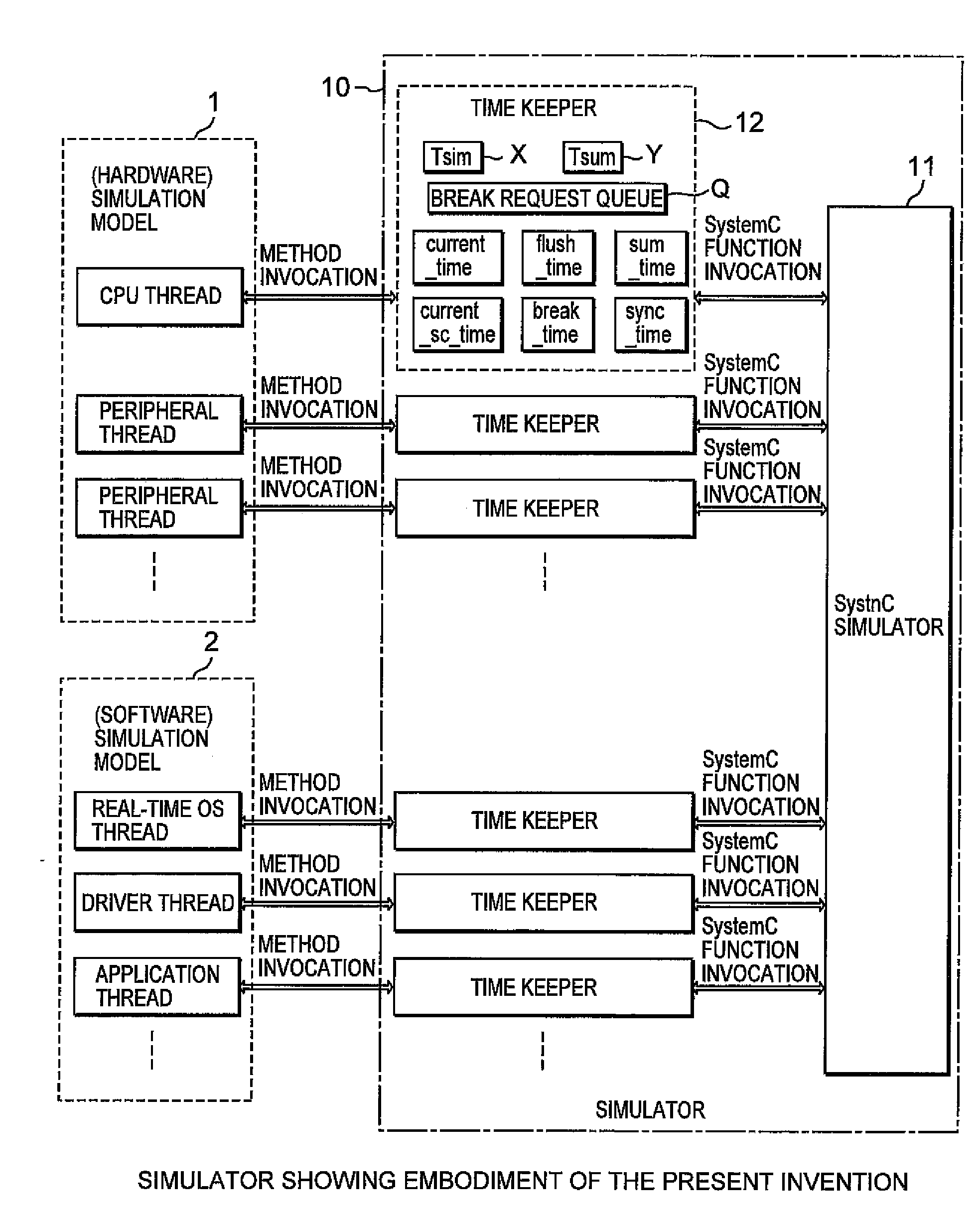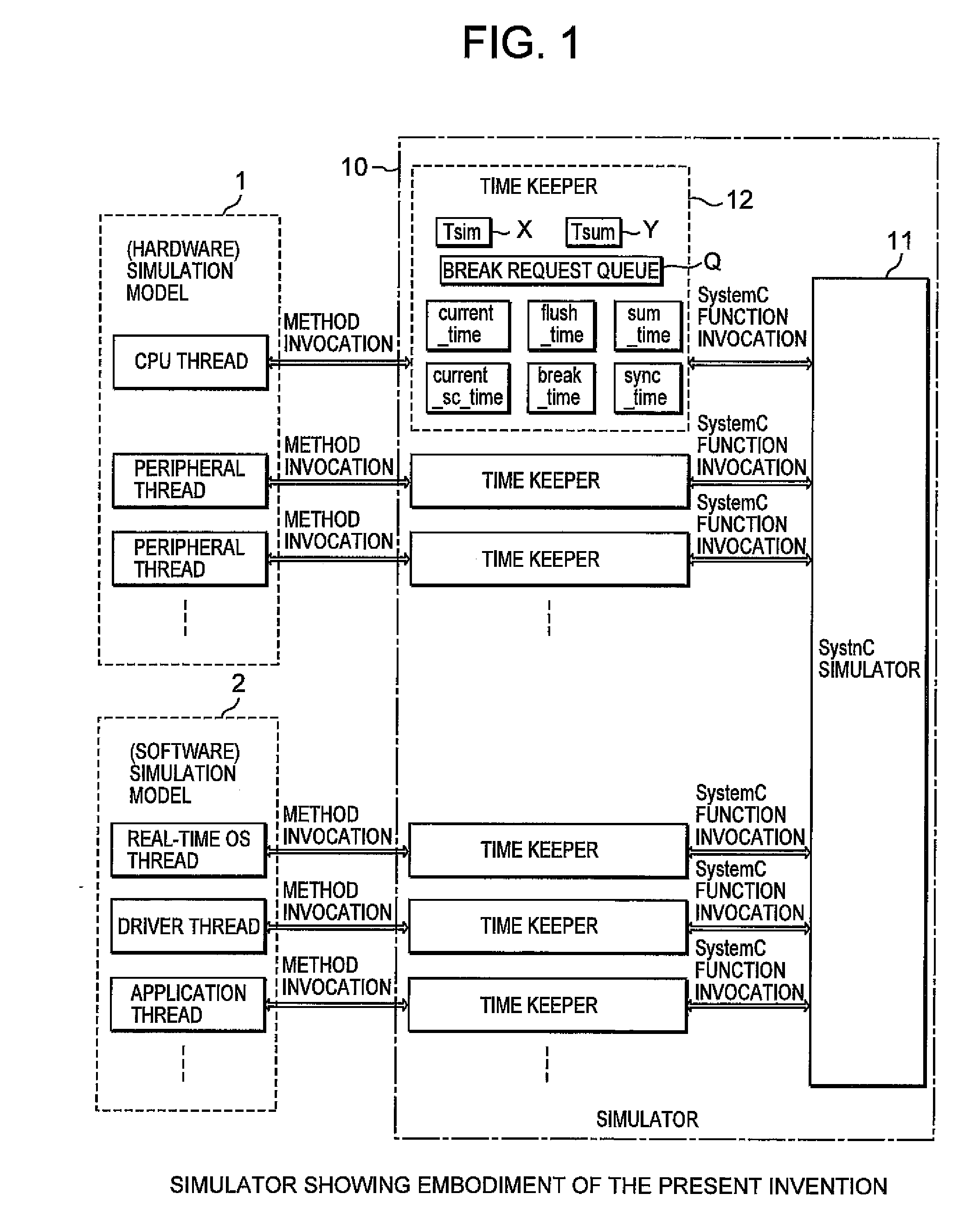Hard/Soft Cooperative Verifying Simulator
a verification simulator and cooperative technology, applied in the field of c language-based hard/soft cooperative verification simulators, can solve the problems of reducing the simulation speed, hdl simulation speed is difficult to provide, and the normal c language encounters difficulties in realizing simulations
- Summary
- Abstract
- Description
- Claims
- Application Information
AI Technical Summary
Benefits of technology
Problems solved by technology
Method used
Image
Examples
first preferred embodiment
[0025]FIG. 1 is a configuration diagram of a simulator showing a first embodiment of the present invention.
[0026]The simulator 10 performs cooperative verification of hardware and software with a SystemC simulator as a base and is configured as one in which a plurality of time keepers 12 are provided in a stage prior to a conventional SystemC simulator 11.
[0027]A simulation model 1 of hardware and / or a simulation model 2 of software are connected to the simulator 10.
[0028]The simulation model 1 of the hardware is equivalent to one obtained by modeling functions of a CPU and various peripheral devices in a SystemC language every sequentially-executed CPU and peripheral devices. The simulation model 1 comprises a plurality of threads created every device. In this configuration, an ISS (instruction set simulator) is utilized as a CPU model usually, where the ISS simulates the CPU behavior executing compiled codes of software programs on instruction by instruction basis, in which the co...
second preferred embodiment
[0184]The second embodiment is equivalent to one in which the function of the sum_time method in each time keeper employed in the first embodiment is extended as follows:
[0185]When a break request queue is not empty and updated Tsim has reached greater than a break time stored at the head of the break request queue, a sum_time method of the second embodiment invokes break methods each corresponding to a break time bTsim lying below Tsim in order from the head of the queue and thereafter deletes these from the queue. Thereafter, a summation time Tsum is added to its corresponding simulation time Tsim to advance the simulation time Tsim, and each elapsed time tim is added to the summation time Tsum to update or renew the summation time Tsum.
[0186]When the summation time Tsum exceeds a threshold value Tthr, a flush_time method invocation is performed. Here, the threshold value Tthr designates the maximum value of the summation time Tsum. When the summation time Tsum exceeds the thresho...
third preferred embodiment
[0189]The third embodiment is provided in which a time keeper integrated module tiks corresponding to a module in which time keepers are integrated, is added to the simulator of the first or second embodiment.
[0190]If all required time keepers are connected to the time keeper integrated module tiks and the time keeper integrated module tiks is connected to respective devices, then the respective devices are capable of referring to these time keepers via the time keeper integrated module tiks.
[0191]Thus, method invocations of necessary time keepers can be performed by providing the time keeper integrated module tiks and connecting the time keeper integrated module tiks to the respective devices. With the connection of the time keeper integrated module tiks, the connection of the time keepers is simplified in a manner just like similar to connections to clocks at a clock synchronous type simulation model.
[0192]The time keeper integrated module tiks has at least methods shown below.
[01...
PUM
 Login to View More
Login to View More Abstract
Description
Claims
Application Information
 Login to View More
Login to View More - R&D
- Intellectual Property
- Life Sciences
- Materials
- Tech Scout
- Unparalleled Data Quality
- Higher Quality Content
- 60% Fewer Hallucinations
Browse by: Latest US Patents, China's latest patents, Technical Efficacy Thesaurus, Application Domain, Technology Topic, Popular Technical Reports.
© 2025 PatSnap. All rights reserved.Legal|Privacy policy|Modern Slavery Act Transparency Statement|Sitemap|About US| Contact US: help@patsnap.com



